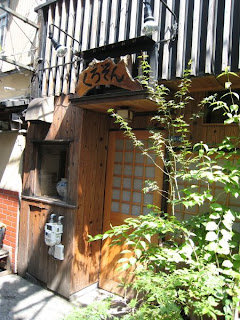
As one might expect, we closed SAKAYA and took the day off on Christmas Day. Expecting a leisurely start to the day, we were surprised to receive a 10 AM phone call from Rick's mother and brother saying that they were heading across the Verazzano Narrows Bridge and would be at our home in Brooklyn shortly. The plan had been for them to arrive around noon, but the holiday traffic from Pennsylvania had been so light that they had made record time. We jumped out of bed, showered, and hastily made coffee to kick us into gear.
 Rick took them to the East Village to show them our store since they had not seen it before. Meanwhile, Hiroko cleaned the house and prepare for the Christmas meal. We had planned to make a roast pork recipe we found on the Food & Wine website. After inserting slivers of garlic into the meat, Hiroko wrapped the pork loin and sprigs of fresh rosemary and thyme with slices of bacon; a simple and easy recipe.
Rick took them to the East Village to show them our store since they had not seen it before. Meanwhile, Hiroko cleaned the house and prepare for the Christmas meal. We had planned to make a roast pork recipe we found on the Food & Wine website. After inserting slivers of garlic into the meat, Hiroko wrapped the pork loin and sprigs of fresh rosemary and thyme with slices of bacon; a simple and easy recipe.Hiroko first baked the dessert, an apple pie, followed by some-lighter- than-air gougeres (parmesan and gruyere cheese puffs) for hors d'oeurves. It was
 then time to put the meat in the oven. Once that had been accomplished, we were able to have a sake toast and relax for a while.
then time to put the meat in the oven. Once that had been accomplished, we were able to have a sake toast and relax for a while.Cooked to perfection, the pork was moist and succulent.
 Along with a wild rice and mushroom pilaf and fennel and celery salad, Hiroko also made a quick and easy side dish of sauteed tomatoes with a touch of garlic. We were then ready to sit down to the first course, a celery root soup with a "surprise" of vinegar and maple syrup to be stirred up from its hiding place at the bottom of the cup.
Along with a wild rice and mushroom pilaf and fennel and celery salad, Hiroko also made a quick and easy side dish of sauteed tomatoes with a touch of garlic. We were then ready to sit down to the first course, a celery root soup with a "surprise" of vinegar and maple syrup to be stirred up from its hiding place at the bottom of the cup.The result of Hiroko's daylong efforts was a delectable, healthy, and comforting feast that made for a tasty conclusion to a memorable and enjoyable Christmas Day.
Roast Bacon Wrapped Pork
One 3-pound boneless pork loin
2 garlic cloves, thinly sliced
salt and freshly ground pepper
4 ounces thinly sliced bacon or pancetta
6 long rosemary springs
6 long thyme springs
- Preheat the oven to 350°. Using a small knife, make 1-inch-deep slits all over the pork. Stuff each slit with a slice of garlic. Season the pork all over with salt and pepper and wrap with the bacon. Top with the herbs, tucking them under the bacon in several spots. Tie the roast at 1-inch intervals with kitchen string.
- Transfer the pork to a roasting pan and roast for 1 hour, or until an instant-read thermometer inserted in the center of the loin registers 130°. Transfer the pork to a cutting board, cover loosely with foil and let rest for 15 minutes. Discard the string and herb sprigs. Carve the loin into thick slices and serve.



























